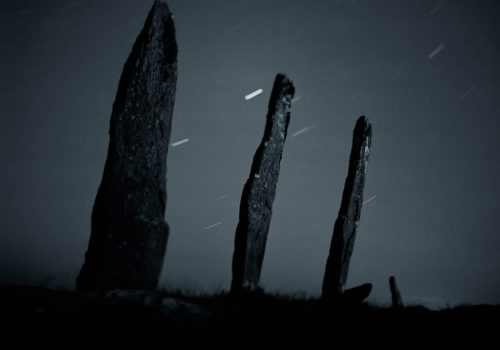The standing, megalithic stones that populate our Earth have attracted people for thousands of years from the Stone Age to the present. While we do not know who constructed the megalithic architectural elements or why, many believe they played an integral role in the religious and spiritual life of early humans. Stonehenge, located in Wiltshire, England, is perhaps the world’s most famous example of a prehistoric monument. 1,023,000 people visited Stonehenge in 2010/11, according to the Stonehenge World Heritage Site. They reported 887,000 visitors in 2008, an increase of more than 12% from 2000, and 15% more people visited in 2000 than in 1990. More people every year are interested in megalithic monuments, but most of them are only aware of Stonehenge. They have no idea how many thousands of ritual stones pre-date Stonehenge by centuries, how many countries have these stones, and how much the configurations vary from one country to another.
In 2003, fine art photographer Barbara Yoshida pitched a tent next to a circle of tall standing stones called the Ring of Brodgar in the Orkney Islands in Scotland. Using a 4 x 5 film camera, she photographed the stones from evening to dawn bathed in moonlight. The results of this shoot inspired her to embark on a project to photograph lesser known stones around the world that were built before Stonehenge. Over the course of the next ten years she travelled to fifteen countries and three continents to seek out and photograph ritual stones, many never documented on film until now. Her exquisite, elegant images of the stones that capture their beauty and timeless quality are published for the first time in Moon Viewing: Megaliths by Moonlight (Marquand Books).
“I am drawn to places that are spiritual and have a depth simultaneously of mystery, timelessness and history. The standing, megalithic stones I’ve been photographing for more than ten years have a timeless quality because they are part of our history, part of the consciousness of every person.” – Barbara Yoshida
Moon Viewing: Megaliths by Moonlight marks the first book to reveal the scope of the geographical distribution of standing stones from Sweden in the north, to Portugal and Spain in the south, east to Italy, Ukraine and Armenia, then around the Mediterranean to Israel, Morocco, and south to The Gambia in West Africa. Yoshida travelled thousands of miles, often not knowing until she arrived at her designated location whether the stones she was looking for would still be accessible, or would now have fences around them or would have been destroyed or removed. She was also aware that once she found the site there might only be one night with clear skies and enough moonlight to shoot them.
Scientific research shows some of the stones were arranged to align with the appearance of certain stars or planets at designated times of the year. As well as being positioned in formations for astronomical observations, the stones were erected so that they pointed to the sky—the stones were therefore connectors between earth and sky. Moon Viewing is also the first photo book to use night photography to emphasize the relationship of standing, megalithic stones to stars and planets as well as the Moon that has always fascinated Yoshida.
Yoshida is attracted to the early stones because in her words they are “undressed – the stones were left rough, not smoothed and shaped by hand … their textures and shapes give a sense of their individual characters, even if their shapes have changed over time.” Her photographs of the stones in the middle of the countryside, isolated moors, and deserts against the backdrop of brilliantly clear and starry skies are revelatory, emphasizing their sculptural qualities, power, and distinct and enduring presence.
Yoshida references the Japanese culture’s special relationship to the Moon and to stones. In Japan, people will travel to pay their respects to certain rocks they believe have especially strong spirits. For the Japanese, these stones are not inanimate objects, but living objects with inner, spirituality. A reverence for all life persists to this day, particularly among Asian cultures that embrace a symbiotic relationship to nature akin to that held by their hunter-gatherer ancestors. In a world that many see as spinning out of control due to a lack of respect for and connection to our natural environment, the stones in Barbara Yoshida’s monograph remind us of our humbleness in the universe and our need to live in more harmony with our Earth before it’s too late.
BOOK
Moon Viewing, Megaliths by Moonlight
Photographs by Barbara Yoshida
Hardcover: 80 pages
Publisher: Marquand Books
Price: $23.62
8.75 x 11.25 inches / 80 PGS / 55 Color
Language: English
ISBN-10: 0988227576
ISBN-13: 978-0988227576
















